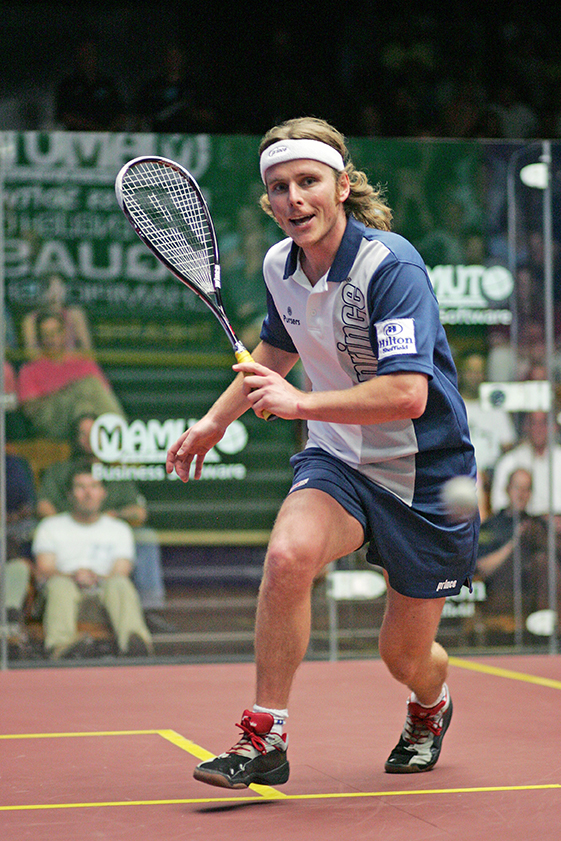By Damon Leedale-Brown, Sports Scientist & Conditioning Specialist
Last month we discussed some of the mechanisms of injury on the squash court that typically are seen when there is too much focus/emphasis on playing, and too little focus on preparing the body to perform and keeping the body healthy.

Looking at some of the best athletes in the world across a range of sports, it is clear that while they spend considerable time practicing their sport, they also incorporate a range of other elements to their training program that help prepare them physically for this level of competition and enable them to maintain a high level of performance through the competitive season without breaking down with injury.
Back in England I was fortunate to work with world class athletes from a number of sports including Diving, Boxing, Figure Skating, Athletics and Golf. For the leading Olympic Divers a typical training week included daily sessions in the pool to work on perfecting technical aspects of the dives in their program; three strength and power development sessions in the gym; dry land training to include trampoline and somersault work in addition to trunk strengthening and shoulder stability exercises; and, to assist with recovery—ice baths, stretching sessions each day, and massage at least once a week.
So what about the World’s leading squash players? What routines do they follow and what can we learn from the way they prepare their bodies for the sport. During the process of writing this article I was fortunate enough to have a timely conversation with Peter Nicol. Peter was more than happy to share his experiences of training, and what he believed were the important factors in enabling him to perform at the highest levels in the sport through a long and successful career without suffering from any major injury setbacks. Peter played on the pro-tour from 1992-2006, was World No. 1 for an unbroken five year period, and top 10 for over 12 years!
As a junior player Peter was involved in a number of sports alongside squash, including soccer, tennis and golf. Playing other sports at this age provided excellent variation in the training stimulus being applied to his young developing body, and helped him avoid the constant repetition of loading through just one sport which has the potential to cause significant problems in the developing athlete—and which I have seen firsthand far too often with young athletes in the US in many sports.
Peter was the first to admit that his approach to training has definitely changed with age and increased knowledge of how best to manage his body. As a young player he felt, without doubt, the area that really helped him cope with exceptionally hard training (and continue to compete at increasingly higher levels on court) was his religious approach to strength training which started when he turned pro at 18. His strength sessions were normally followed by a 15-20 minute swim and time in a hydrotherapy pool, both of which have been shown to be useful recovery techniques. Peter was strict with his stretching and mobility work on a daily basis around his training sessions and, during major training phases, had three massages a week without fail (at considerable cost to a young player on the pro tour with limited financial resources!). He continued with his dedicated approach to strength training throughout his career and always felt that it helped ‘reset’ his body and kept him feeling solid and balanced on court.
Toward the latter phases of his career,Peter also introduced some new training modalities which, again, have been helpful in changing up the stimulus to his body and keeping things fresh. This included restorative Yoga, use of a ‘Power Plate’ vibration training system, and an increased emphasis on core strength training. At 38-years-old, Peter is still able to compete at a very high level, and attributes his current body health to yoga, circuit-based strength sessions whenever he has the opportunity, and long walks with his dog in Scotland! He looks forward to continued competitive outings in 2011 on the newly formed Legends of Squash Tour (www.LegendsOfSquash.com).
So what are the main lessons that players of all ages and abilities can take away from the experiences of one of the best players of all time, who has managed to avoid the pitfalls of injury that have cut short the careers of many highly ranked players?
Integrate strength training into your conditioning to help maintain the stability, balance and structural integrity of your musculo-skeletal system, and better tolerate the forces imposed on your body during matchplay. Around periods of training and matchplay be disciplined with following appropriate stretching and mobility routines on a daily basis where at all possible. If you have the financial resources, consider finding the services of an experienced sports massage therapist, ideally on a weekly or bi-weekly basis. Try a range of different recovery techniques to find out what works best for your body (e.g., swimming, hydrotherapy). Mix in some different sports or cross-training activities to change up the stimulus and loadings patterns on your body. Do some Yoga. And if these aren’t enough ideas for you, buy a dog that needs plenty of exercise!





